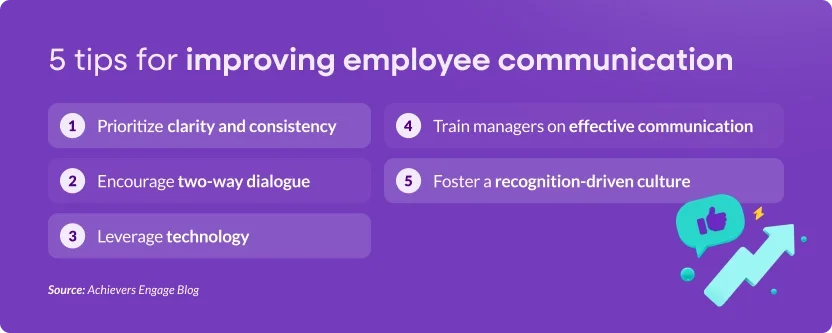Table of contents
In the workplace, strong employee communication is the heart of employee engagement, productivity, and retention. When employees and leaders openly share ideas, organizations thrive. However, effective communication is often overlooked.
In fact, a study found that 61% of employees considering leaving their jobs cite poor internal communication as a factor. Prioritizing effective communication helps contribute to a culture of transparency and trust, both of which play a key role in an engaged workforce.
Want to up the employee communication efforts at your company? Read on to discover practical tips and how to create a more connected, high-performing team.
5 methods of communication in the workplace
The five key methods of workplace communication — verbal, written, nonverbal, digital, and visual — each play a vital role in fostering clear and effective cross-functional interactions. Leveraging all five methods maintains consistency in company messaging, helping employees not only understand what is being communicated, but also feel valued. Here’s a quick breakdown of each:
- Verbal communication: Face-to-face meetings, phone calls, video conferences, and presentations.
- Written communication: Emails, reports, memos, and documentation.
- Nonverbal communication: Body language, facial expressions, and tone of voice in conversations.
- Digital communication: Instant messaging applications, collaboration platforms, and internal social networks.
- Visual communication: Infographics, charts, training videos, and dashboards.
What is the key to good employee communication?
The key to good employee communication is to foster a company culture of authentic, open and consistent communication across all levels of your organization. Here’s how each of these principles can be applied to communication in the workplace:
- Authenticity: Building genuine relationships, leading with empathy, and clearly defining your goals and values.
- Openness: Practicing and encouraging active listening, embracing diverse perspectives, and creating a feedback-friendly environment.
- Consistency: Scheduling regular check-ins for updates and feedback and using an agenda or schedule for meetings.
Creating a safe space for employees to speak openly and honestly creates an environment in which collaboration thrives, trust is established, and everyone works toward a shared vision, reinforcing a great employee experience.
The best ways to communicate with employees at different levels
Communicating with all levels of employees is not a one-size-fits-all approach; what may work for senior leadership may not resonate with frontline employees. Communication methods need to be tailored to different roles, so messages are understood and valued across an organization.
One overarching theme that applies to all levels of employees though, is encouraging employee feedback. Creating opportunities for employees to share their thoughts invites trust and transparency, translating to increased engagement and retention. Whether through forums, instant messaging apps, regular check-ins, or newsletters, feedback matters.
Here are a few ways to tailor communications to certain employee groups:
Frontline workers
Employees who directly interact with customers or the public typically deal with hands-on work. These types of employees are usually on the move and away from desks, and best benefit from communication styles that prioritize time effectiveness, as well as quick and easy feedback opportunities with their managers.
Mobile-friendly communication tools, such as instant messaging apps, or digital bulletin boards ensure that important information can be accessed quickly. Providing real-time updates through SMS or internal chat platforms make it easy for frontline employees to check in every so often at their convenience, without facing any barriers.
Many frontline employees also interact with their peers on a day-to-day basis, making peer-to-peer recognition integral for company morale. With platforms like Achievers that help streamline and encourage peer-to-peer recognition, organizations can foster a culture where employees feel connected and motivated.
Peer-to-peer
While employees hold various roles, their peers are among the people they interact with the most. For this reason, prioritizing peer-to-peer communication strengthens workplace relationships, boosts company morale, and encourages collaboration.
To integrate peer-to-peer communications, businesses can utilize shared team messaging apps like Slack or Microsoft Teams, allowing for employees to connect in real time. Other strategies include:
- Creating forums or virtual spaces, where employees can share ideas, feedback and support with one another
- Encouraging informal check-ins with managers and employees to discuss ongoing tasks and thoughts in a casual setting
- Implementing mentorship program opportunities helps to strengthen workplace relationships, bridging senior and junior employees to support each other in an organization.
Additionally, social recognition tools like Achievers help employees feel valued and appreciated by recognizing and celebrating their wins and contributions, helping your business grow and thrive.
Mid-level managers
Mid-level managers play a crucial role in balancing shifting tasks, and delegating projects and assignments, serving as a bridge between employees and leadership. Regular team check-ins, whether through video calls or in-person meetings, are among the best ways to keep them aligned with their teams and minimize communication overload.
Using structured feedback loops can help managers quickly relay employee concerns to leadership while receiving valuable feedback themselves. This two-way communication fosters trust and efficiency, allowing for issues to be addressed promptly.
Employee feedback tools, like Achievers, offer customizable employee feedback software that helps record real-time data to maintain consistent, positive, and actionable communication, boosting employee engagement, motivation, and productivity across your organization.
Senior leadership and executives
Senior managers, executives, and directors are the voice of a company, playing a critical role in shaping company culture, defining objectives, and driving organizational success. By clearly communicating the company vision through town halls, video messages, or newsletters, senior leadership helps keep employees informed and aligned.
To foster transparency and accessibility, executives should make an effort to be available to employees through AMA (Ask Me Anything) sessions. These interactive events allow the audience (employees) to ask leadership questions, fostering transparency, authenticity, and stronger connections between leaders and employees.
Looking for ways to connect leadership with employees? Achievers’ recognition features allow companies to highlight executives who actively communicate and engage with employees, building a culture of openness and collaboration in your workplace.

General tips for improving employee communication
A recent FlexOS report found that 30% of employees feel frustrated by unclear communication from their bosses. Prioritizing strong communication translates to teams that are more aligned, engaged, and productive. Here are some ways to improve employee communication:
- Prioritize clarity and consistency: Avoid mixed messaging by setting clear expectations and using the right communication channels. Keep messaging concise and direct, ensuring they align with company actions to prevent confusion.
- Encourage two-way dialogue: Foster interactive engagement and understanding by implementing open-door policies and anonymous constructive feedback tools. Encourage colleagues to share concerns and verify if messaging is clear.
- Leverage technology: Utilize digital platforms like Slack, Microsoft Teams, and Achievers for seamless interaction. Choose the most effective communication tools for different contexts; for example, use email for formal communications and project management tools for task tracking.
- Train managers on effective communication: Equip leaders with training in active listening, empathetic communication, and feedback techniques. Part of manager effectiveness includes creating a safe space to work, giving and receiving feedback, and communicating openly.
- Foster a recognition-driven culture: Use the Achievers platform to publicly acknowledge contributions. A culture of recognition makes employees feel valued and reinforces increased motivation and engagement.
How employee recognition programs improve communication
Employee recognition programs strengthen workplace communication by promoting transparency, encouraging dialogue, and fostering collaboration. By leveraging feedback and real-time data insights, these programs help identify and address communication gaps immediately, creating a more connected and engaged work environment.
Here are some other ways employee recognition programs improve communication:
- Bridges the gap between employees and leadership: Public recognition fosters visibility and appreciation across all levels. This builds trust and boosts engagement, reinforcing that employee efforts are meaningful and impactful.
- Encourages peer-to-peer communication: Recognition creates a positive feedback culture, making employees more comfortable sharing praise and constructive feedback. When appreciation becomes a daily habit, it encourages open communication and stronger team collaboration.
- Provides real-time feedback: Continuous recognition offers employees instant validation, helping them understand their impact. This ongoing feedback loop boosts motivation and performance, creating a cycle of positive workplace behaviours that reinforce productivity.
- Creates a positive workplace narrative: Recognition highlights company values in action, turning employee achievements into stories that help create the company’s culture and mission internal communication.
Stronger communication, stronger teams
Ineffective communication comes at a cost. Businesses lose $1.2 trillion annually due to ineffective communication, with employees spending nearly 20% of their time navigating poorly written messages.
The Achiever’s employee experience platform helps organizations eliminate these costly inefficiencies while prioritizing employee engagement and well-being. By fostering a culture of trust and transparency through effective communication and recognition on the Achievers platform, you gain the benefit of a more motivated and productive workforce, ultimately contributing to long-term company-wide success.



